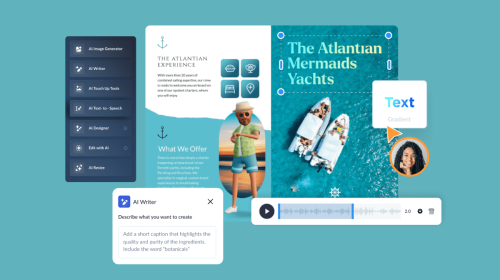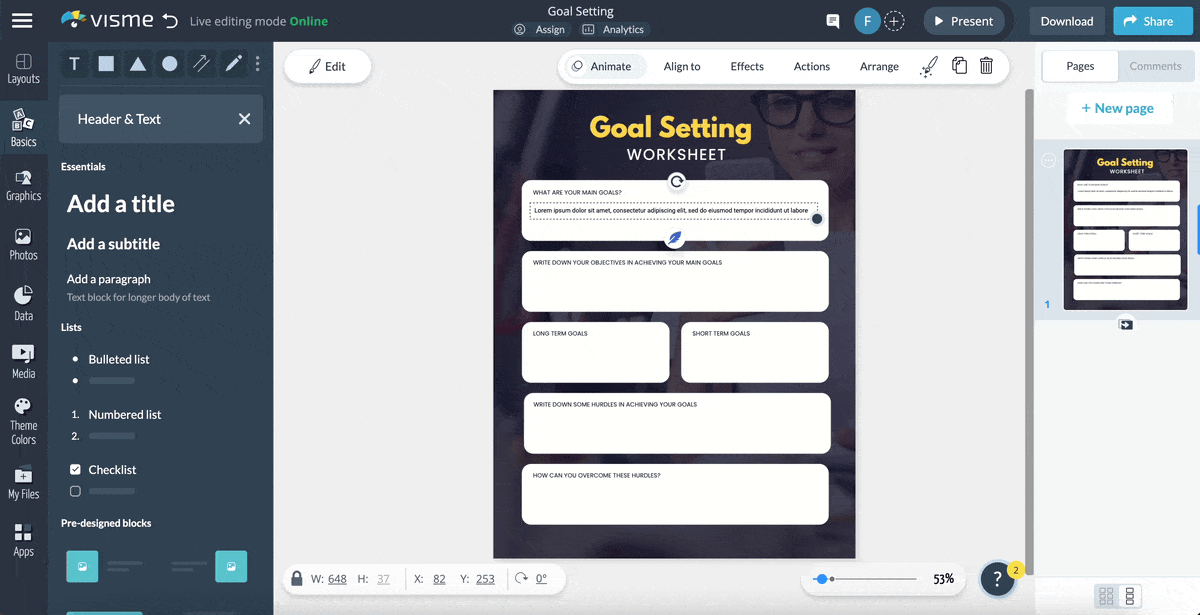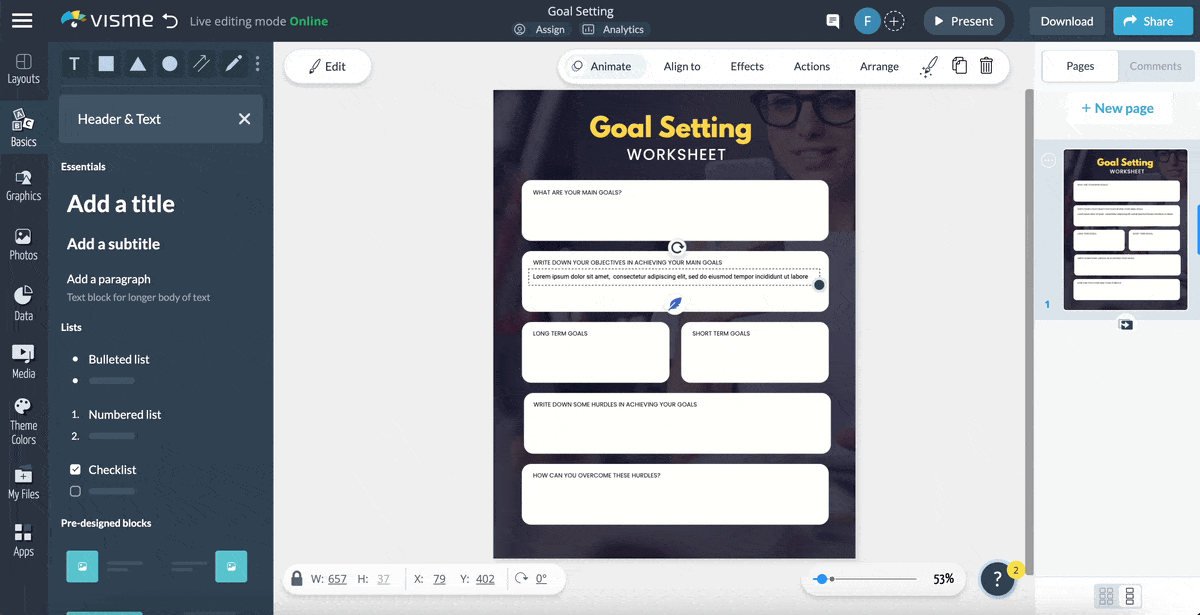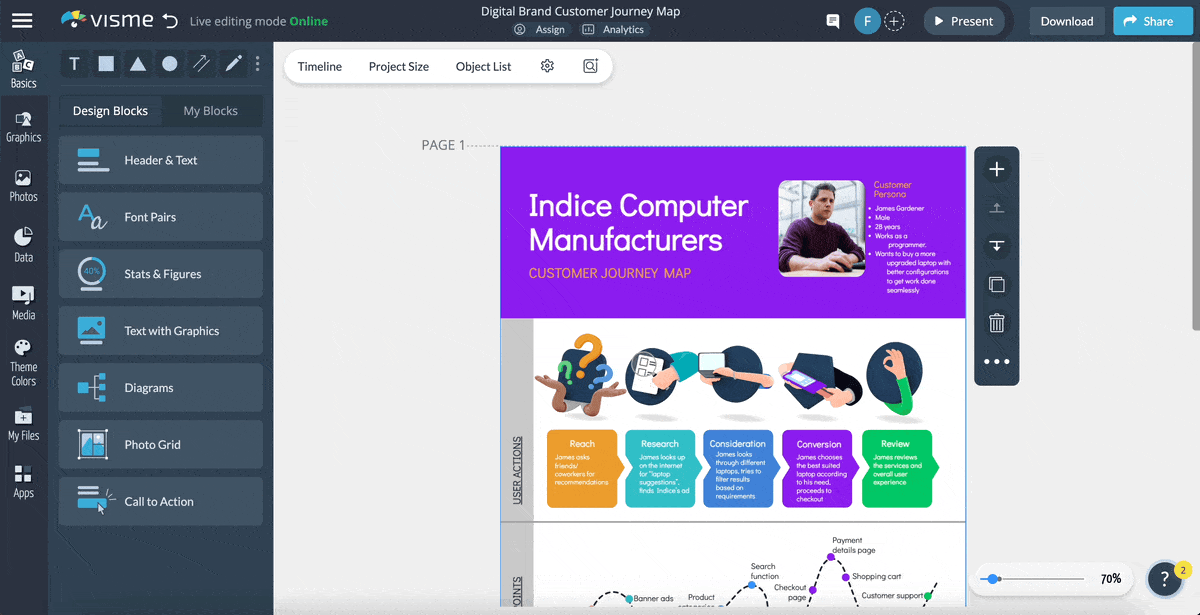
A Practical Guide to Creating Customer Success Training for New Clients [Including Templates]
![A Practical Guide to Creating Customer Success Training for New Clients [Including Templates]](https://visme.co/blog/wp-content/uploads/2023/10/A-Practical-Guide-to-Creating-Customer-Success-Training-for-New-Clients-Header-scaled.jpg)
![A Practical Guide to Creating Customer Success Training for New Clients [Including Templates]](https://visme.co/blog/wp-content/uploads/2023/10/A-Practical-Guide-to-Creating-Customer-Success-Training-for-New-Clients-Header-scaled.jpg)
Businesses thrive on happy customers. These people don’t just buy from you—they endorse your products, spread the word and keep coming back for more.
But keeping customers happy can be a challenge, especially if they don’t fully grasp the value of your product. That’s why you need an effective customer success process to onboard new clients and help them understand your product so they can enjoy their purchase.
And just like all teams, customer success teams need proper training to do their job.
In this post, we’ll show you what customer success training is, why you need it and how to plan and execute it successfully in your company.
Customer success training is the process of equipping your team with the skills, knowledge and tools they need to ensure customers get maximum value from your product or service.
It’s not just about addressing issues—it's about proactively helping your clients achieve their desired outcomes.
That’s why customer success training programs often focus on building communication skills employees need to effectively listen, understand, empathize, guide and explain.
Customer success training prepares your team to onboard, educate and guide clients in the best possible way.
It makes them confident and well-prepared to handle any issues that can potentially arise in their role. The result? Happier customers, more sales and faster growth for your business.
Here are some specific benefits of customer success training:
Leading to happier customers who become loyal brand advocates, spreading positive word of mouth about your business.
For instance, let’s say your software company launches a new feature. Without proper SaaS customer success training, your team might struggle to explain it’s benefits to clients.
The result? Clients won’t be able to use the feature properly to achieve their goals.
But with targeted training, your team can not only explain the feature but also guide clients on best practices so they get the most out of it.
Happy customers are less likely to switch to a competitor. Why does this matter? Research shows the probability of selling to existing customers is 14 times higher than for new prospects!
Made with Visme
Customer success training not only reduces churn and also encourages repeat purchases, which boosts your average customer lifetime value (CLTV.)
Plus, satisfied customers are more likely to buy into upsell and cross-sell offers. All of this translates into more revenue for your business.
Customer success training equips your team with essential skills to delight customers at every step of their journey.
This knowledge helps improve their confidence and makes them more productive and happier in the long run. They end up dealing better with clients and staying longer with your company.
Happy customers are more likely to leave good reviews, which you can turn into visual testimonials and add to your website and sales materials.
They can also provide honest feedback and suggestions, fill out surveys and answer any questions for research purposes. You can use this data to fuel product development, such as releasing a new and useful feature, and make profitable business decisions.
RELATED: 12 Customer Success Software to Help Your Business in 2024
So, you’re ready to draft a customer success training program.
But how do you go about planning and implementing it? Is there a specific process?
What tools and templates can you use? In this section, we cover it all.
Follow the steps below to design training your employees (and clients) will thank you for:
Made with Visme Infographic Maker
The first step is to identify the key areas and skills you want the training to focus on. These should align with your client’s needs, expectations and potential challenges.
Once you’ve done that, you can set clear objectives and design a customer success training program that helps you achieve those goals.
For example, you might notice a significant number of escalated client queries about a specific product feature. Based on this insight, your objective could be:
"Enable employees to handle 90% of [feature]-related client queries without escalation."
This would require employees not just to understand your product in-depth but also to master soft skills like negotiation and empathy.
Make sure you get your customer-facing team to pitch in and even review the assessment. They might be able to provide insights based on previous experiences with clients.
Visme’s goal-setting worksheets are perfect for this stage. Use them to visualize your objectives and get a holistic view of your training goals, capturing both hard and soft skill targets.

You can easily share your goals with team members and key stakeholders. Get their input with collaboration tools, and edit your objectives without scrapping the project completely.
Pro Tip: Make sure you set SMART objectives. Instead of a vague "Improve client communication," go for "Reduce client communication response time to under 2 hours.
The next step is to translate your objectives into a structured curriculum. This involves breaking down each goal into smaller, teachable units or modules.
For example, if one of your objectives is to improve product knowledge, you might have modules like:
This is also where you plan how to deliver your training. Is the training online? Will you offer in-person classes or workshops? Are you going to use a blended learning or hybrid learning approach?
The methods you use will impact the way you design your curriculum and content.
With Visme's presentation templates, you can create a visual syllabus or course outline. This can serve as a guide for both trainers and trainees. Also, the consistency in design ensures your training materials look cohesive, professional and on-brand.
Visme presentation template
With your curriculum in place, it's time to develop the content for each module. Here are some ideas for creating engaging content for your customer success training program:
Webinars are a great way to educate employees on how to handle things practically. Invite industry experts or experienced customer success professionals to speak at your webinar for real-world insights. Make sure you incorporate time for a Q&A session at the end. Craft amazing webinar presentations with Visme using built-in icons, AI image generator, data visualization and more.
Digital courses that incorporate quizzes, drag-and-drop activities and simulations allow learners to participate actively. For example, you can have a mini test with Multiple Choice Questions (MCQs) on how to best respond to a client frustrated with a premium product feature.
Use real-life examples and scenarios to make the content relatable and engaging. For example, if you're training employees on handling client complaints, use actual interactions (with sensitive information removed) as case studies.
Video guides for processes, tools or best practices in action offer a dynamic and visual way to understand complex topics. For example, you can create a tutorial that showcases how to navigate a new feature using screen recordings from actual user sessions. Or, you can make a customer service training video that educates employees on how to respond to product-related complaints.
Training manuals provide employees with a clear instructional guide containing processes, FAQs, and troubleshooting steps in one accessible resource. They can also store all training materials or be integrated into a learning management system (LMS). Using a training manual template removes guesswork, and creating it digitally ensures easy updates and seamless sharing without hiccups.
Interactive decision trees are practical training methods to help clients troubleshoot software or items before contacting customer success or support. When you make a troubleshooting or training tree interactive, you can interlink support pages, videos and more so that they're structured in a way that doesn't overwhelm the client.
These make for excellent training materials as they distill complex information into easy-to-digest visuals.
For example, you could create a cheat sheet that breaks down the steps to resolve a frequent client issue. Or an infographic that maps out the client journey with your brand.
Want to make your training content stand out? Visme's vast library of graphics, videos and interactive elements can be incredibly useful here.
Instead of a slide with bullet points on "Handling Client Complaints," imagine an interactive slide where clicking on each point reveals a short video or animation.

This not only makes the training more engaging but also helps retain attention for longer. Make it even better by aligning your materials with your company’s branding using the Brand Wizard.
Pro Tip: While it's tempting to pack in as much information as possible, remember “less is more." Try to focus each slide or module on one key idea or concept to avoid cognitive fatigue. Need help? Use Visme’s AI text generator to write succinct copy that captures your message in the best possible way.
Training content shouldn't be developed in a silo. Collaborate with experienced members of other teams, gather their insights and refine the content.
Your employees can provide real-world examples, common client pain points and effective resolution strategies that can be invaluable for the training.
Visme’s collaboration features are perfect for this. You can share drafts with team members, gather inline feedback and make edits in real-time. This helps you create content that’s both theoretically sound and practically relevant. Here's how Visme's collaboration feature works
Pro Tip: Organize a pilot training session with a small group of customer success team members. Treat this as a beta test. The feedback from this session can help you identify gaps, areas of confusion and opportunities for improvement before the actual rollout.
With your content ready, it's time to roll out the training. First, schedule your sessions based on employee availability and preferences.
Then, make sure all your tech and logistics are in place.
Visme lets you share and publish your training content directly on its platform. This means employees can access training materials anytime, anywhere, without needing third-party tools.
And if you want to integrate Visme projects with your internal learning management system (LMS), you can easily export them in xAPI or SCORM formats.
Next, execute the training. Start each session with clear objectives, such as a “What we’ll learn today” slide, to set expectations and get trainees excited. Similarly, end your sessions with a quick recap to go over key takeaways.
Use Visme to make your training content visually engaging. Take advantage of interactive features and add quizzes, real-time polls, videos, links and more to your slides.

Conducting training online? Use Visme's analytics to track participant engagement. Use that data to adjust pacing or focus areas in future sessions.
 Pro Tip:Encourage participation by adding discussions, breakout sessions or group activities. This helps break the monotony, enhances understanding and also fosters team collaboration. Don’t forget to provide supplementary resources after each session to reinforce learning.
Pro Tip:Encourage participation by adding discussions, breakout sessions or group activities. This helps break the monotony, enhances understanding and also fosters team collaboration. Don’t forget to provide supplementary resources after each session to reinforce learning.
Don’t just sit back once the training is delivered. Gather feedback to gauge the effectiveness of the program and to identify areas for improvement.
Here are some questions to ask trainees at this stage:
Instead of generic feedback forms, use Visme’s form builder to whip up visually appealing and easy-to-fill surveys. You can create all kinds of custom forms, add animation and design elements to make them more engaging, and then publish or embed them online.
Personalize your forms for each individual employee by adding Dynamic Fields like names, positions and more.
Pro Tip: Send out feedback forms immediately after the training session when the content is still fresh in your participants’ minds. Delaying this might get you vague or incomplete feedback that’s difficult to analyze or use.
Yes, there’s still another step after getting feedback. You also need to analyze whether the customer success training worked by tracking employee performance. That’s how you’ll know how well you met your initial training objectives.
Periodically monitor how your team is applying their training in real-world scenarios. For instance, if one of the training modules was on "Advanced Product Features," check in after a month to see how confidently they explain these features to clients.
Use Visme to design dashboards that track key performance indicators (KPIs) related to the training. For instance, a dashboard could track metrics like "Number of escalated client queries" or "Average response time post-training."
Pro Tip: Consider setting up refresher sessions or advanced modules based on the feedback and monitoring. Continuous learning ensures your customer success team is always equipped with the latest knowledge and best practices.
Training in customer success involves a combination of formal educational sessions, hands-on experience and continuous learning. It encompasses understanding the product or service, mastering soft skills like communication and empathy, and using tools and data to monitor and enhance customer experiences.
A Customer Success Manager (CSM) ensures clients derive maximum value from a product or service. They act as a bridge between the client and the company, proactively addressing client needs, resolving challenges and building long-term, positive client relationships.
Key skills for customer success include strong communication, problem-solving, empathy, product knowledge, data analysis and project management. Additionally, a deep understanding of customer needs, adaptability and the ability to work collaboratively are essential.
While there’s no strict educational path for a CSM, degrees in business, marketing, communications or related fields can be beneficial. But more importantly, you need hands-on experience, customer success manager training, product knowledge and familiarity with customer relationship management tools.
The 3 C’s of customer success are: Customers (understanding their needs and expectations), Communication (maintaining clear, open channels for feedback and support), and Collaboration (working together with customers to ensure they achieve their desired outcomes with the product or service.)
The benefits of effective customer success training are clear: happier customers, a confident team and insights that can help grow your business.
To design a training program that checks all the boxes, you need the right tool. This is where Visme steps in. It’s simple, dynamic and works in your browser. At the same time, it’s a powerful, all-in-one content creation platform that eliminates the need for any other tool. You can create, collaborate on and share interactive, on-brand training courses.
Access built-in graphics, thousands of professional templates, AI-powered tools and more. Host your training materials directly on Visme, download them as PDF or image files, or export projects in xAPI and SCORM formats to integrate with your LMS.
Learn more about how Visme can help training and development teams design amazing courses and execute training programs that leave a mark.
Design visual brand experiences for your business whether you are a seasoned designer or a total novice.
Try Visme for free